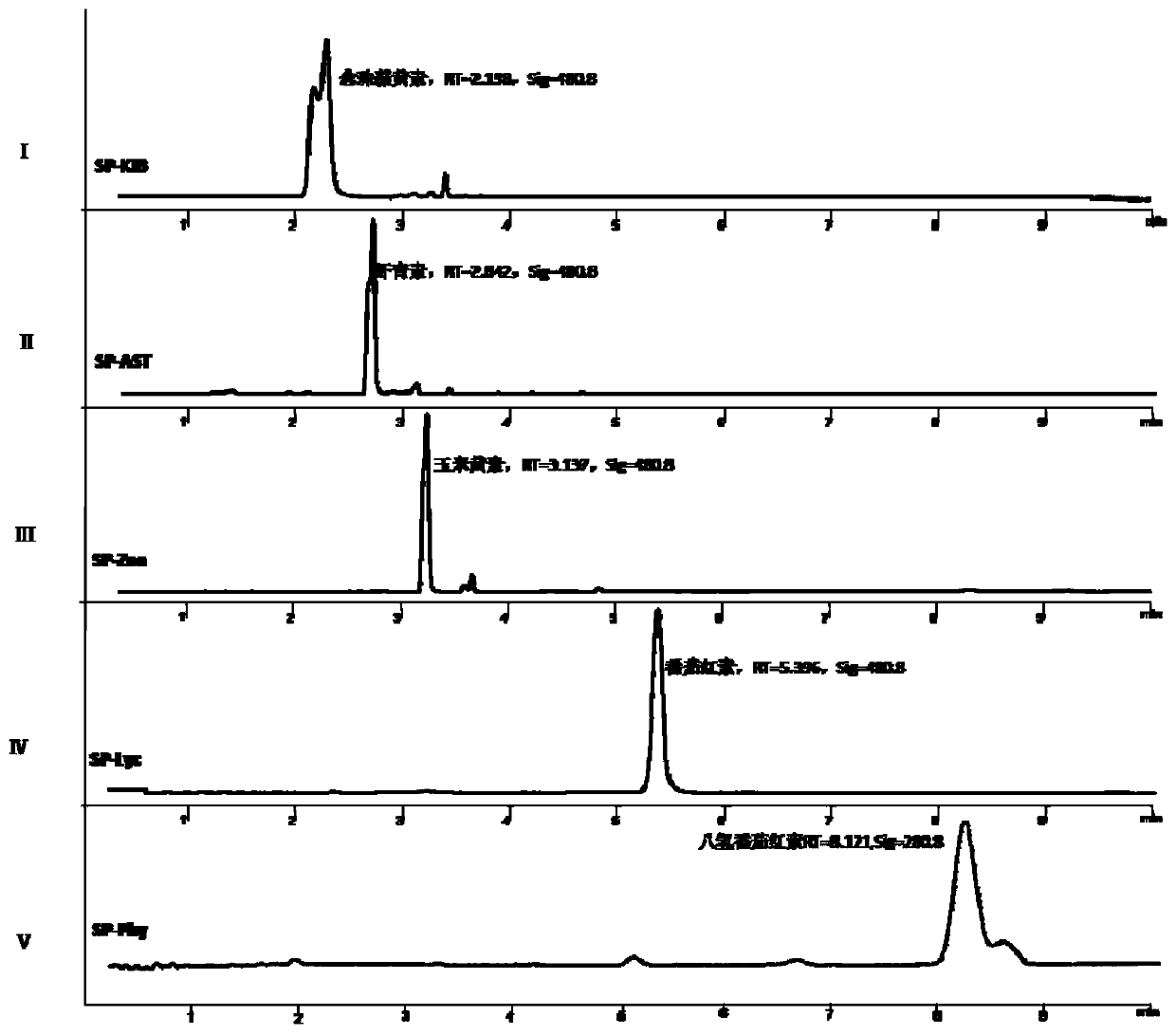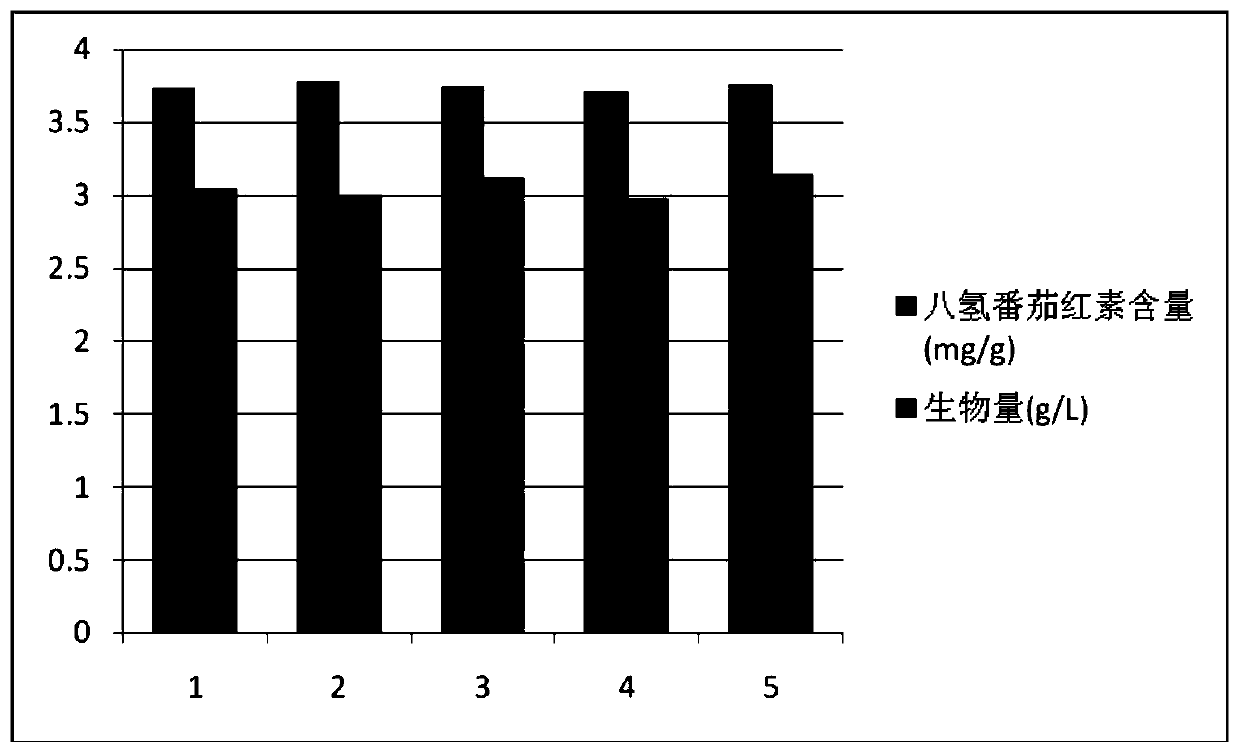Sphingomonas and method for producing carotenoids therewith
A technology of sphingomonas, sphingobiumsp.kib, which is applied in the preparation of carotenoids and in the field of biology, and can solve the problems of long cycle time, low animal utilization rate, and large floor area
- Summary
- Abstract
- Description
- Claims
- Application Information
AI Technical Summary
Problems solved by technology
Method used
Image
Examples
Embodiment 1
[0081] Breeding of Sphingomonas phytoene-producing strain SP-Phy.
[0082] The starting strain KIB of Sphingomonas: isolated by our laboratory, is a pollutant on the plate medium when the marine microalgae Aurantiochytrium sp.SK4 is cultivated. The plate medium formula is: 5g glucose, 2g yeast extract, 50% artificial seawater, 8g agar powder and distilled water are fully mixed and the volume is adjusted to 1L with distilled water; sterilized at 121 degrees Celsius for 20 minutes; cultured in artificial seawater: 30gNaCl, 0.7gKCl, 10.8gMgCl 2 ·6H 2 O, 2.638gMgSO4, 0.756gCaCl 2 Mix well with distilled water and make up to 1L with distilled water. The bacterium is bright in color, and the colony is smooth and round. Pick a single clone in LB culture medium, cultivate at 28 degrees Celsius and 220 rpm. Sphingobium sp. was preserved on April 25, 2016 in the General Microbiology Center of China Committee for Culture Collection of Microorganisms (Address: Institute of Microbiology...
Embodiment 2
[0102] Breeding of Sphingomonas lycopene-producing strain SP-Lyc.
[0103] (1) The starting strain of Sphingomonas was inoculated into the slant of LB agar medium, and cultured at 28° C. for 48 hours. LB agar medium is peptone 10g / L, yeast extract 5g / L, sodium chloride 10g / L, pH 6.5;
[0104] (2) Pick a ring of bacteria from the activated slant and inoculate it into the shake flask, culture at 28°C, 220rpm for 12-18h, so that OD600=0.7-0.9, wherein the shake flask medium is TB medium: 24g of yeast extract / L, peptone 12g / L, glucose 4g / L, K 2 HPO 4 ·3H 2 O 16.416g / L,KH 2 PO 4 2.312g / L, pH 6.5;
[0105] (3) Take 10 mL of the above-mentioned cultured bacterial solution, collect the bacterial cells by centrifugation, wash the bacterial cells twice with an equal volume of phosphate buffered saline solution, and collect the washed bacterial liquid by centrifugation;
[0106] (4) NTG mutagenesis: add 10 mL of phosphate-buffered saline to the cells obtained by centrifugation, ...
Embodiment 3
[0122] Breeding of zeaxanthin-producing strain SP-Zea from Sphingomonas sp.
[0123] (1) Inoculate the sphingomonas strain KIB into the slant of LB agar medium, and culture it at 28°C for 48 hours. The LB agar medium is 10g / L of peptone, 5g / L of yeast extract, and 10g / L of sodium chloride. L, pH 6.5;
[0124] (2) Pick a ring of bacteria from the activated slant and inoculate it into a shake flask, culture at 28° C., 220 rpm for 12-18 hours to make OD600 = 0.7-0.9, wherein the shake flask medium is TB. TB medium is yeast extract 24g / L, peptone 12g / L, glucose 4g / L, K 2 HPO 4 ·3H 2 O 16.416g / L, KH 2 PO 4 2.312g / L, pH 6.5;
[0125] (3) Take 10 mL of the above-mentioned cultured bacterial solution, collect the bacterial cells by centrifugation, wash the bacterial cells twice with an equal volume of phosphate buffered saline solution, and collect the washed bacterial liquid by centrifugation;
[0126] (4) NTG mutagenesis: add 10 mL of phosphate-buffered saline to the cells o...
PUM
 Login to View More
Login to View More Abstract
Description
Claims
Application Information
 Login to View More
Login to View More - R&D
- Intellectual Property
- Life Sciences
- Materials
- Tech Scout
- Unparalleled Data Quality
- Higher Quality Content
- 60% Fewer Hallucinations
Browse by: Latest US Patents, China's latest patents, Technical Efficacy Thesaurus, Application Domain, Technology Topic, Popular Technical Reports.
© 2025 PatSnap. All rights reserved.Legal|Privacy policy|Modern Slavery Act Transparency Statement|Sitemap|About US| Contact US: help@patsnap.com



